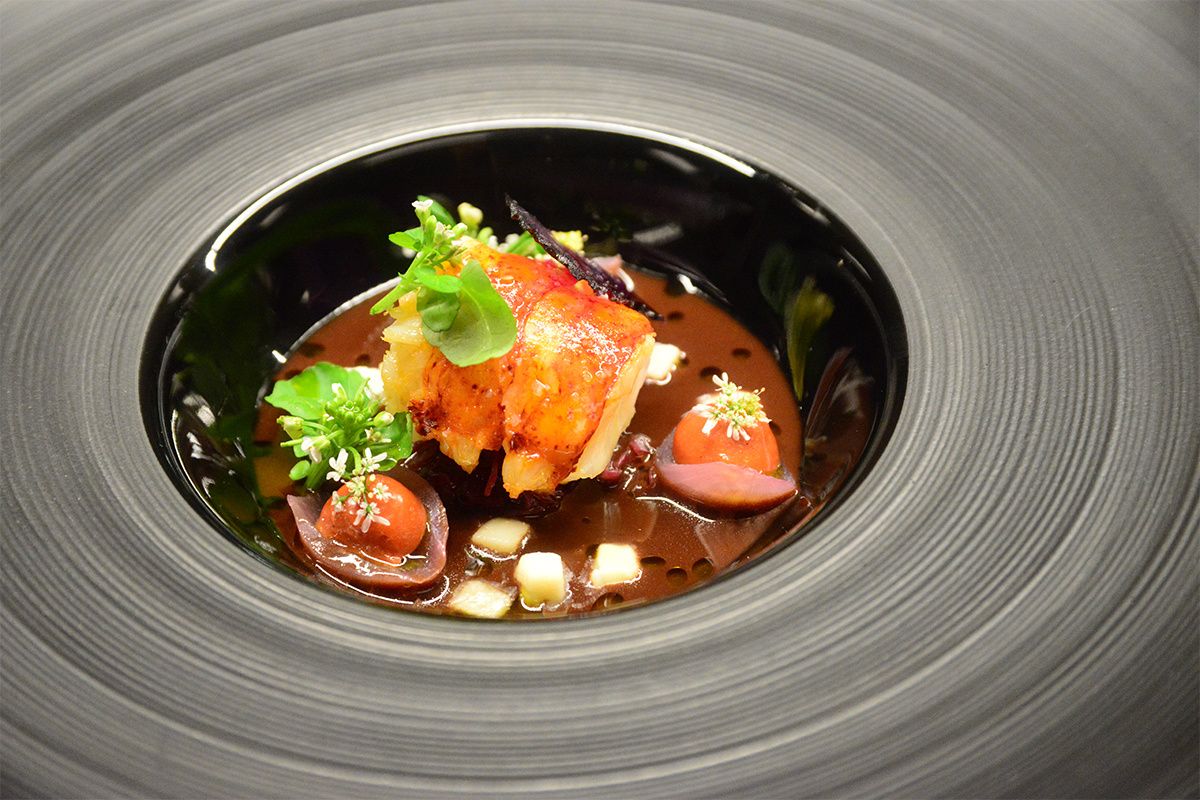When it comes to functional design, few structures in the history of architecture rival the ingenuity of international airports, not only for the efficiency with which they facilitate transport to distant lands, but for the virtuosity with which they shepherd travelers past the splendors of the duty free and all manner of other concessions on the way to their ultimate destinations.
This is not a non sequitur, but a thought that came to mind while riding the elevator up to O' by Claude Le Tohic, the gastronomic restaurant occupying the top two floors of One65, a multi-level culinary venue that opened in May, a block from San Francisco's Union Square.
You don't just walk into O' off the street, as it were. No, because beckoned by an atmosphere of butter, yeast, and sugar, rather than making a beeline for the elevator, you detour through the ground floor patisserie, reviewing an army of delights—Napoleons, eclairs, tropeziennes, brioches, croissants, berry tarts, a Pantone palette of macarons, and two dozen kinds of chocolates—as well as a carefully curated assortment of staples ranging from sea-salted Breton butter and Alain Millat fruit preserves to Pommery mustard and pretty silver tins of niçoise olive oil. So as you're going up in the lift, making note of the fact that you're ascending past One65 Bistro & Grill and Elements Bar & Lounge, you're also subconsciously compiling your end-of-the-night shopping list.
If it all seems particularly well thought out, perhaps it's because the concept was, in some sense, decades in the making, the vision of a chef who has dedicated his life to the art and craft of French cuisine.
Claude Le Tohic was born in Vannes, a city on the Gulf of Morbihan in southern Brittany. His mother ran a creperie, his father made cider; at the earliest opportunity, his parents put him to use.
"I was very young," Le Tohic recalled, "six or seven years old. "I was working with my father, making cider and drinking cider. My mom was putting me on boxes, and I was doing the draft cider, the draft beer... If you do that in the U.S.," he added conspiratorially, "you would be in trouble." By the time he was 12, he said, "I knew I wanted to work in the hospitality business, because I always loved the connection with the guest, and the speed of service."
Le Tohic attended culinary school in Vannes, an experience quite different from a typical culinary education in the U.S. "The way you do school in France is called apprentissage, which is half school and half working in the restaurant. Your training is very accurate, based on the business model. Here, you go to school, we teach you something, and that's it. There, you're inside of a service."
On graduating, Le Tohic stayed close to home, taking on a two-year apprenticeship at Les Hortensias, a one-Michelin-star restaurant near the touristic port town of La Trinité-sur-Mer. The food was familiar, said Le Tohic, "regional food from Brittany. So I started to work with a lot of fish and seafood." His next posting was in Lille in northern France, at the Belgian-born chef Ghislaine Arabian's two-Michelin-star Le Restaurant.
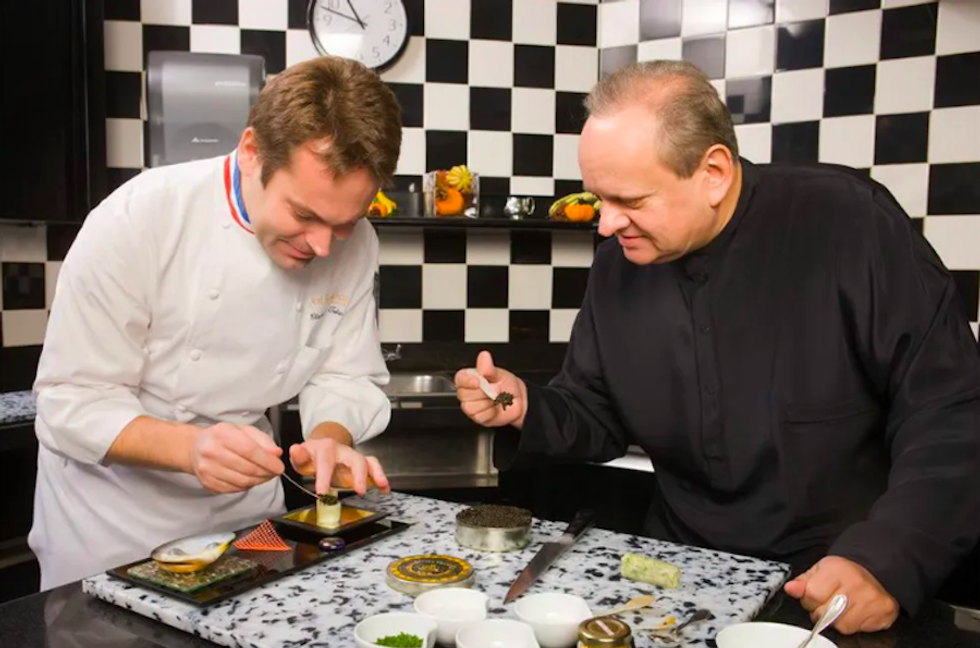
In 1987, at the age of 19, Le Tohic moved to Paris for a job that would shape his career for years to come. "In '87, it was difficult to find a position in the three-star Michelin, because so many people wanted to work on this level," he said. "I was looking for a great chef."
The great chef in this case was the legendary Joël Robuchon; the restaurant, Jamin. Before he began working there as chef de partie, Le Tohic said, "I didn't know much about Joël Robuchon. But when I got the chance, I quickly understand who was Mr. Robuchon, and the way he was working in the kitchen." The latter was a revelation. "He was a chef very, very precise. Everything in the kitchen you put some thought behind. You weigh everything—salt, pepper—not by intuition. It was very new for me. The rigor in the kitchen was very extreme. You got a lot of people who could not work in this kind of kitchen, because there was a lot of pressure."
Le Tohic handled the pressure adroitly, staying two years before embarking for a mandatory year of military service. He then spent several years in the kitchens of a pair of Relais & Châteaux properties in Brittany and Normandy before joining the culinary faculty at Le Centre de Formation des Apprentis Interconsulaire de l'Eure, an organization that trains apprentices in a variety of trades. In 2004, Le Tohic received the Meilleur Ouvrier de France award, for his dedication to the preservation, advancement, and perpetuation of traditional French cuisine.
"It's a big deal in France," Le Tohic said of the award, "the highest distinction you can get in the kitchen. You start with 600 chefs, and a couple of chefs get to the final. To be honest, after this competition, you get a lot of attention." Some of that attention came from a former employer and fellow Meilleur Ouvrier de France. "It was late at night," Le Tohic recalled. "Mr. Robuchon called me and said, 'Hey, I want you back. We're opening a complex in Las Vegas, a gastronomic restaurant and a L'Atelier de Joël Robuchon. I want you to take care of these two restaurants.' I said 'I need to give you an answer when?'" "Tomorrow," Robuchon replied. "I talk all night to my wife," said Le Tohic. "I call the day after, and say 'I'm in.'"
The restaurants—Robuchon's first in the U.S.—would be built in the MGM Grand which, along with a number of other casinos, sought to woo culinary travelers to Las Vegas by partnering with renowned French chefs, including Guy Savoy, Pierre Gagnaire, and Alain Ducasse.
"It was a big change, moving to Las Vegas," said Le Tohic. "To be honest, it took two years to adjust myself." The culture shock didn't impair his effectiveness as executive chef though and, in 2008, three years after the opening, Restaurant Joël Robuchon was awarded three Michelin stars, an accomplishment yet unrivaled in the desert gaming capital.
In 2016, Le Tohic traveled to San Francisco, where a six-story building at 165 O'Farrell offered an intriguing possibility for vertical integration. "I came up with the idea to put four different concepts in the same building," said Le Tohic. It was a dauntingly complex project, but ultimately, the chef said, "I'm proud of the way we designed the operation. It's very well done."
Among its cleverest features are a kind of minor factory, on the second floor, that centralizes the production of everything from baguettes and boudin noir to bûche de Noël, and a system of dumbwaiters that allows Elements Bar & Lounge to swiftly shuttle cocktails to both restaurants, obviating the need for a bar in either. The peak achievement though is O', where Le Tohic deliciously demonstrates the enduring appeal of modern French cuisine.
Contrary to lingering prejudice about French cooking, a distinct lightness distinguishes the current winter tasting menu, which kicked off with a tiny tartlet, its scalloped crust filled with a delicate jasmine-tea-and-carrot mousse topped with a many-petaled flower cut from a slice of kabocha squash. The next dish, a study in red, combined an unctuous, sweet-tart pomegranate gazpacho, a smoky-sweet beet confit cooked overnight in a Josper charcoal oven, and a deep-fried crisp of dehydrated beet purée as illicitly crunchy as a kettle-cooked potato chip. And to wash them down, a dryly citrusy Monochrome from Champagne Jean-Pierre Launois, the first in a series of spot-on pairings by O's wine director, the newly vinted Master Sommelier Vincent Morrow.
(Nick Czap)
Le Tohic's take on French cuisine is decidedly light, as in the lobster gelée, gernanium, and corn velouté—part of his Caviar Composition.
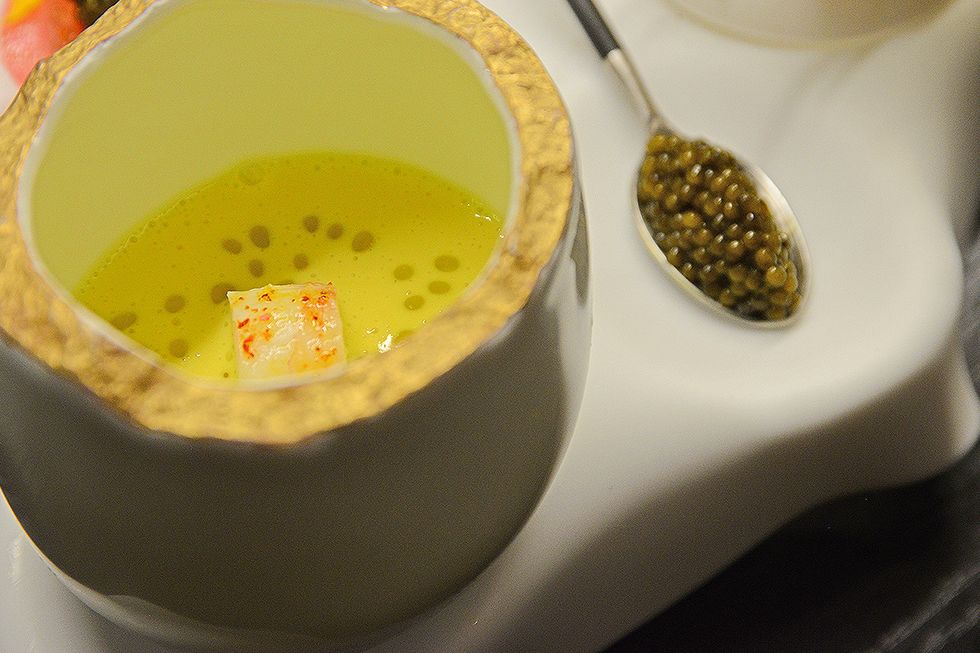
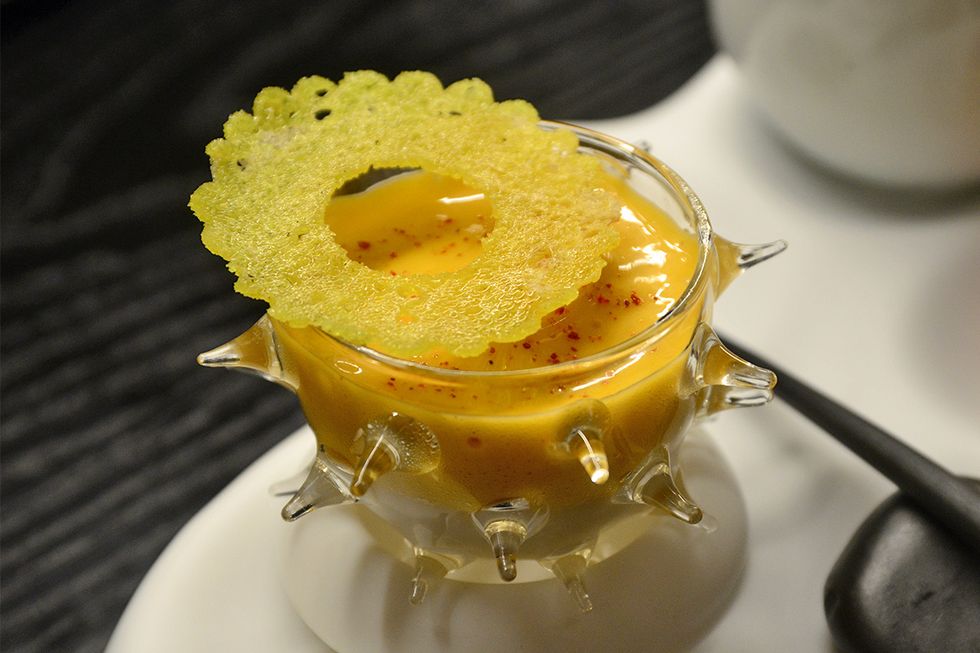
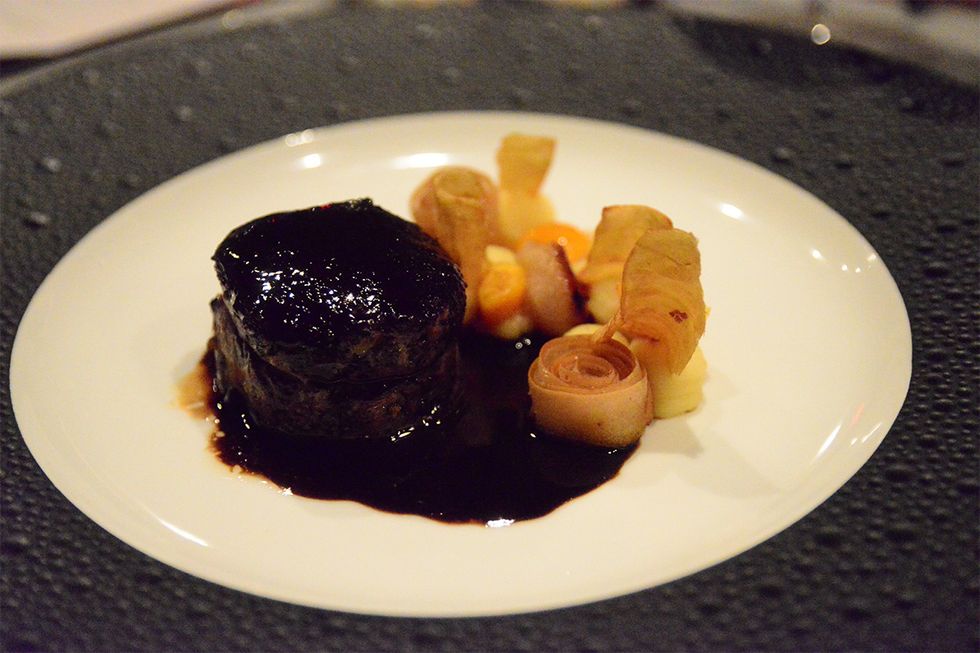
As the starters suggest, French cuisine is no longer an inviolable fortress of tradition. "If you go back to France," said Le Tohic, "you can see a strong personality and identity in the French food, but I think French cuisine can be influenced by different types of cuisine, like Asian cuisine, and South American also. We started to think about what was happening around us, not only about French ingredients. Of course the cuisine changed, but the technique is still there."
One can ponder this duality while savoring the fine, marine essence of the uni sabayon, or the corn velouté studded with slivers of geranium-infused lobster gelée that play leading roles in Le Tohic's Caviar Composition. The fundamental recipes for sabayons and veloutés can be found in the pages of Le Guide Culinaire, Auguste Escoffier's 1903 codification of classic French cuisine, although Le Tohic's interpretations have a decidedly contemporary feel.
"Ten years ago," said Le Tohic, "French cuisine was pretty heavy—lots of cream, butter. We changed, and did things differently. It doesn't mean we don't cook French any more, but we use less butter, less cream, and make everything lighter. I want guests to feel good when they leave, not stuffed, even if you want to enjoy the mignardises cart."
It was by no means the first time French chefs have adapted to changing times. In the early 1960s, Paul Bocuse's nouvelle cuisine took aim at the heaviness and ornamentation of grande cuisine, which Escoffier and his peers had streamlined once before, in the 19th century, as it migrated from the dining halls of palaces to the restaurants of palace hotels.
Where Le Tohic refuses to compromise is on the matter of sauce. "When a lot of people wanted to eat light," said Le Tohic, "chefs started to eliminate sauce. A lot of fine dining restaurants said 'We cannot put sauce any more.' And after that we started to put some emulsion. It's beautiful, but guess what happens when you put it on the table. It's air. It looks nice but it doesn't taste good. Cuisine with no sauce is boring. I'm sorry, but it's no good."
As dogmatic as that might sound, it rings true. How many emulsions I've poked at and forgotten I couldn't say, but I suspect I may never forget a dish of roasted lobster with bone marrow and sous vide-fermented red cabbage in a sauce au Chambertin et genièvre. Made from reductions of red wine and veal jus seasoned with juniper, shallot and organic black miso, the depths of its earthy, softly sweet flavor were enough to take my breath away. Just as captivating was a stout little cut of roasted venison, its contours reflected in the mirror-like surface of a sauce grand veneur, a broodingly fruity concoction of venison bone stock, vinegar, sugar, pepper, juniper, red currant liqueur, and the merest splash of cream.
If you find yourself feeling the least bit self-conscious about sopping up every last fleck with your brioche or baguette, rest assured that the chef approves. "I see so many times, guests taking a piece of bread and eating the sauce on the plate," said Le Tohic. "People who love food take a piece of bread and enjoy the sauce."
// O' by Claude Le Tohic, 165 O'Farrell St., one65sf.com



